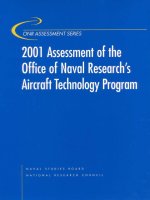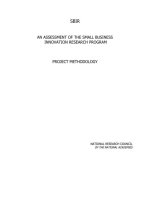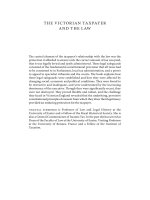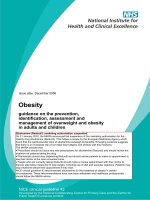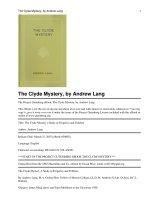In the Middle of the Fight - An Assessment of Medium-Armored Forces in Past Military Operations doc
Bạn đang xem bản rút gọn của tài liệu. Xem và tải ngay bản đầy đủ của tài liệu tại đây (1.62 MB, 337 trang )
This document and trademark(s) contained herein are protected by law as indicated
in a notice appearing later in this work. This electronic representation of RAND
intellectual property is provided for non-commercial use only. Unauthorized
posting of RAND PDFs to a non-RAND Web site is prohibited. RAND PDFs are
protected under copyright law. Permission is required from RAND to reproduce,
or reuse in another form, any of our research documents for commercial use. For
information on reprint and linking permissions, please see RAND Permissions.
Limited Electronic Distribution Rights
Visit RAND at www.rand.org
Explore the RAND Arroyo Center
View document details
For More Information
This PDF document was made available
from www.rand.org as a public service of
the RAND Corporation.
6
Jump down to document
THE ARTS
CHILD POLICY
CIVIL JUSTICE
EDUCATION
ENERGY AND ENVIRONMENT
HEALTH AND HEALTH CARE
INTERNATIONAL AFFAIRS
NATIONAL SECURITY
POPULATION AND AGING
PUBLIC SAFETY
SCIENCE AND TECHNOLOGY
SUBSTANCE ABUSE
TERRORISM AND
HOMELAND SECURITY
TRANSPORTATION AND
INFRASTRUCTURE
WORKFORCE AND WORKPLACE
The RAND Corporation is a nonprofit
research organization providing
objective analysis and effective
solutions that address the challenges
facing the public and private sectors
around the world.
Purchase this document
Browse Books & Publications
Make a charitable contribution
Support RAND
This product is part of the RAND Corporation monograph series.
RAND monographs present major research findings that address the
challenges facing the public and private sectors. All RAND mono-
graphs undergo rigorous peer review to ensure high standards for
research quality and objectivity.
Prepared for the United States Army
Approved for public release; distribution unlimited
ARROYO CENTER
In the Middle of the Fight
An Assessment of Medium-Armored
Forces in Past Military Operations
David E. Johnson
t
Adam Grissom
t
Olga Oliker
The RAND Corporation is a nonprofit research organization providing
objective analysis and effective solutions that address the challenges
facing the public and private sectors around the world. RAND’s
publications do not necessarily reflect the opinions of its research clients
and sponsors.
R
®
is a registered trademark.
© Copyright 2008 RAND Corporation
All rights reserved. No part of this book may be reproduced in any
form by any electronic or mechanical means (including photocopying,
recording, or information storage and retrieval) without permission in
writing from RAND.
Published 2008 by the RAND Corporation
1776 Main Street, P.O. Box 2138, Santa Monica, CA 90407-2138
1200 South Hayes Street, Arlington, VA 22202-5050
4570 Fifth Avenue, Suite 600, Pittsburgh, PA 15213-2665
RAND URL:
To order RAND documents or to obtain additional information, contact
Distribution Services: Telephone: (310) 451-7002;
Fax: (310) 451-6915; Email:
Cover photos courtesy of the U.S. Army Center of Military History
The research described in this report was sponsored by the United States
Army under Contract No. W74V8H-06-C-0001.
Library of Congress Cataloging-in-Publication Data
Johnson, David E., 1950 Oct. 16–
In the middle of the fight : an assessment of medium-armored forces in past
military operations / David E. Johnson, Adam Grissom, Olga Oliker.
p. cm.
Includes bibliographical references.
ISBN 978-0-8330-4413-6 (pbk. : alk. paper)
1. United States. Army—Armored troops. 2. United States. Army—Armored
troops—History. I. Grissom, Adam. II. Oliker, Olga. III. Title.
UA30.J62 2008
358'.18—dc22
2008029010
iii
Preface
e U.S. Army is in the midst of a major restructuring and transfor-
mation effort to prepare itself for the challenges of the 21st century.
Its ultimate objective is to create a campaign-quality army with joint
and expeditionary capabilities. As part of its transformation, the U.S.
Army is fielding medium-armored forces, the Stryker brigade combat
teams (SBCTs), to give the current force increased capability. Medium-
armored forces are also central to the U.S. Army’s vision of the Future
Force, with the Future Combat Systems–equipped brigade combat
teams considered an important component of that force.
is report presents a historical analysis of how medium-armored
forces have performed across the range of military operations since
World War I. Its purpose is to help inform U.S. Army decisions about
the Future Force.
is research was sponsored by the U.S. Army and conducted
within the RAND Arroyo Center’s Strategy, Doctrine, and Resources
Program. RAND Arroyo Center, part of the RAND Corporation, is
a federally funded research and development center sponsored by the
U.S. Army.
Because this study was initiated prior to Fiscal Year 2002, there
is no Project Unique Identification Code (PUIC) associated with this
project.
iv In the Middle of the Fight
For more information on RAND Arroyo Center, contact the
Director of Operations (telephone 310-393-0411, extension 6419; fax
310-451-6952; email ), or visit Arroyo’s Web
site at />v
Contents
Preface iii
Figure and Tables
ix
Summary
xi
Acknowledgments
xix
Abbreviations
xxi
CHAPTER ONE
Introduction 1
e Army Future Force
1
e Past as Prologue
5
Monograph Objective and Parameters
8
Tasks
9
Definitions
9
Methodology
10
Cases
14
Monograph Organization
14
CHAPTER TWO
Medium-Armored Forces in Operations at the High End of the Range
of Military Operations
17
Armored Warfare in the Spanish Civil War (1936–1939)
17
e Armored Forces
18
Employment
19
Key Insights
23
U.S. Armored Forces Versus German Armored Forces in Western Europe
During World War II (1944–1945)
24
vi In the Middle of the Fight
e Armored Forces 24
Employment
28
Key Insights
40
U.S. Army Armored Cavalry and Mechanized Infantry in Vietnam (1965–
1972)
42
e Armored Forces
44
Employment
49
Key Insights
51
Task Force Shepherd, 1st Marine Division, in Operations Desert Shield
and Desert Storm (Southwest Asia, 1990–1991)
52
e Armored Forces
55
Employment
55
Key Insights
63
CHAPTER THREE
Medium-Armored Forces in the Center of the Range of Military
Operations
65
Soviet Airborne Operations in Czechoslovakia (1968)
65
e Armored Forces
68
Employment
68
Key Insights
70
South Africa in Angola (1975–1988)
71
e Armored Forces
73
Employment
75
Key Insights
82
Soviet Operations in Afghanistan (1979–1989)
83
e Armored Forces
92
Employment
94
Key Insights
97
U.S. Forces in Operation Just Cause (Panama, 1989)
97
e Armored Forces
101
Employment
104
Key Insights
105
Russia in Chechnya (1994–2001)
106
Chechnya I
107
Chechnya II
114
Contents vii
e Armored Forces 119
Employment
120
Key Insights
122
U.S. Stryker Brigade Combat Teams in Operation Iraqi Freedom (2003–
2005)
123
e Stryker Brigades
124
Employment
128
Key Insights
130
CHAPTER FOUR
Medium-Armored Forces in Operations at the Lower End of the
Range of Military Operations
131
e Rescue of Task Force Ranger (Somalia, 1993)
131
e Armored Forces
134
Employment
135
Key Insights
136
Australia and New Zealand in East Timor (1999–2000)
137
e Armored Forces
142
Employment
142
Key Insights
145
CHAPTER FIVE
Conclusions 147
What Unique Capabilities Have Medium-Armored Forces Brought to
Past Conflicts, and Where Along the Spectrum of Operations Have
ey Been Most Valuable?
147
How Have Medium-Armored Forces Performed in Complex Terrain
in the Past?
150
What Advantages Has the Rapid-Deployment Capability of Medium-
Armored Forces Provided to Operational Commanders in the Past?
151
Implications for the U.S. Army Future Force and the FCS
152
Conceptual Choices Matter and Shape Initial Capabilities
152
Medium Armor Can Be Disadvantaged Against Competent Heavy
Forces and Vulnerable in Complex Terrain
154
viii In the Middle of the Fight
Combined Arms and Force Quality Can Mitigate the Inherent
Advantages of Heavy Armor
155
Final oughts
155
APPENDIXES
A. DOTMLPF, BOS, Characteristics of a Transformed Force, and
Complex Terrain Synthesis for Case Studies
157
B. Individual Case Study Assessments of DOTMLPF, BOS,
Characteristics of a Transformed Force, and Complex Terrain
173
C. Definitions
261
Bibliography
271
Index
297
ix
Figure and Tables
Figure
1.1. e Range of Military Operations 15
Tables
S.1 Case Studies xii
1.1 Case Studies
12
2.1 Armored Vehicles in the Spanish Civil War
19
2.2 Principal U.S. Armored Vehicles
26
2.3 Principal German Armored Vehicles
27
2.4 U.S. Armored Vehicles in Vietnam
48
2.5 Task Force Shepherd Medium Armor in Operations Desert
Shield and Desert Storm
56
2.6 Iraqi Armor in Operations Desert Shield and Desert Storm
57
3.1 Soviet Airborne (VDV) Armored Vehicles in
Czechoslovakia
69
3.2 South African Armored Vehicles in the Angolan Border
War
74
3.3 Angolan Armored Vehicles in the Angolan Border War
76
3.4 Soviet Armored Vehicles in Afghanistan
93
3.5 U.S. Armored Vehicles in Panama
102
3.6 PDF Armored Vehicles in Panama
102
3.7 Russian Federal and Chechen Armored Vehicles
115
3.8 Russian Armored Vehicles in Chechnya
121
3.9 Stryker Variants
127
4.1 Armored Vehicles Supporting Task Force Ranger
135
x In the Middle of the Fight
4.2 Australian and New Zealand Armored Vehicles in
INTERFET
143
A.1 DOTMLPF Insights by Case Study
158
A.2 BOS Insights by Case Study
163
A.3 Army Transformation Characteristics by Case Study
165
A.4 Complex Terrain Experience by Case Study
170
xi
Summary
e purpose of this study is to draw insights about medium-armored
forces from past operations to help inform decisions about U.S. Army
transformation and the design of the Future Force. e study is a
qualitative assessment of the employment of medium-armored forces
in the 20th century and it relies on a multicase, comparative histori-
cal approach. We assess U.S. and foreign experiences to analyze how
medium forces performed across the range of military operations in
complex terrain and against different types of opponents, as shown in
Table S.1.
Tasks
e project’s sponsor specified three central questions for the study:
What unique capabilities have medium-armored forces brought t
to past conflicts, and where along the spectrum of operations have
they been most valuable?
How have medium-armored forces performed in complex terrain t
in the past?
What advantages has the rapid deployment capability of medium-t
armored forces provided to operational commanders in the past?
Methodology
We used historical research, mainly as supplied in secondary sources,
to select and develop the cases studied in this report. At the sponsor’s
request, we assessed each case from several perspectives:
xii In the Middle of the Fight
Table S.1
Case Studies
Case Complex Terrain
Point in the Range of
Military Operations Type of Operation
Types of Armored Vehicles and
Other Forces
Armored warfare during the
Spanish Civil War (1936–1939)
Broken and
mountainous;
urban
High Major operations
(civil war with
external support to
both sides)
German and Italian medium-
armored vs. Soviet Union
heavy
U.S. armored divisions in France
and Germany during World War
II (1944–1945)
Urban; hedgerows;
forests
High Major operations U.S. medium-armored vs.
German heavy
Armored cavalry and mechanized
infantry in Vietnam (1965–1972)
Jungle High Major operations;
counterinsurgency
operations
U.S. medium-armored and
heavy vs. Viet Cong and
North Vietnamese light
Soviet airborne operations in
Prague, Czechoslovakia (1968)
Urban Middle Strike (regime change) Soviet Union medium-
armored and heavy vs.
Czechoslovakian light (mainly
civilian forces)
South Africa in Angola (1975–
1988)
Close;
undeveloped
infrastructure
Middle Major operations;
raids
South African medium-
armored vs. Angolan heavy
Soviet Union in Afghanistan
(1979 –1989)
Urban; mountains;
undeveloped
infrastructure
Middle Strike (regime change);
counterinsurgency
operations
Soviet Union medium-armored
and heavy vs. Afghan light
Operation Just Cause, Panama
(1989)
Urban Middle Strike (regime change) U.S. medium-armored vs.
Panamanian medium and
light
Summary xiii
Case Complex Terrain
Point in the Range of
Military Operations Type of Operation
Types of Armored Vehicles and
Other Forces
1st Marine Division light armored
vehicles (LAVs) in Operations
Desert Shield and Desert Storm,
Southwest Asia (1990–1991)
Desert; limited
visibility
High Major operations U.S. (Marine Corps) medium-
armored vs. Iraqi heavy and
medium
Task Force Ranger in Mogadishu,
Somalia (1993)
Urban Low Raid U.S. light and coalition
(Malaysian and Pakistani)
medium-armored vs. Somali
light
Russia in Chechnya I (1994–1996)
and II (1999–2001)
Urban; mountains Middle Counterinsurgency
operations;
combating terrorism
Russian medium-armored and
heavy vs. Chechen light
Australia and New Zealand in
East Timor (1999–2000)
Urban; jungle;
undeveloped
infrastructure
Low Peace operations Australian and New Zealand
medium-armored vs. rebel
light
SBCTs in Operation Iraqi Freedom
(OIF) (2003–2005)
Urban Middle Counterinsurgency
operations;
combating terrorism
U.S. medium-armored vs.
indigenous Iraqi and foreign
fighter light
Table S.1—Continued
xiv In the Middle of the Fight
How were medium-armored forces employed, and why does this t
monograph define them as “medium-armored”?
What doctrine, organization, training, materiel, leadership t
and education, personnel, and facilities (DOTMLPF) insights
emerge?
1
What are the battlefield operating system (maneuver, fire support, t
air defense, command and control, intelligence, mobility/counter-
mobility/survivability, and combat service support) implications?
Which operational characteristics that the U.S. Army expects of a t
transformed force (i.e., responsiveness, deployability, agility, ver-
satility, lethality, survivability, and sustainability) surfaced, or did
not?
How did the medium-armored force under examination perform t
in the case environments (i.e., complex terrain)?
What key insights emerge?t
Finally, the sponsor asked us to describe any overarching insights that
are common among cases.
Key Findings
Several cases examined in this study show the critical difference that
even small numbers of medium-armored forces can make, particularly
in augmenting light forces or when operating independently in raids or
strikes. In Somalia, Malaysian and Pakistani armor provided the pro-
tected mobility and firepower required to extricate cutoff elements of
Task Force Ranger. Similarly, U.S. medium-armored forces in Panama
during Operation Just Cause provided a needed edge to light forces,
and even the modest number of deployed M551 Sheridans provided
an important capability at crucial moments in the early stages of the
campaign. U.S. Marine Corps LAV units were an important economy-
of-force and reconnaissance element during Operation Desert Storm.
Medium-armored forces gave Australia and New Zealand the capability
1
e facilities aspects of DOTMLPF are not addressed in this monograph, however.
Summary xv
to range widely and rapidly across East Timor with protected mobility
sufficient to meet the threat. Furthermore, SBCTs were able to provide
rapid response across a large operational area in Iraq, with greater sur-
vivability than light forces. Finally, medium-armored forces are more
able to operate in areas with less-developed infrastructure. is was the
case in Panama, where M551 Sheridans could cross bridges that could
not support U.S. main battle tanks.
Having the capacity to rapidly deploy medium-armored forces
(by air or sea) may be an important national capability. is was appar-
ent in operations by the South African Army (SAA) in Angola and in
the Australian response to East Timor. Rapidly deployable medium-
armored forces were also an important capability in the coup de main
operations conducted by the Soviet Union in Czechoslovakia and
Afghanistan. Currently, the U.S. Army does not have a forced-entry,
medium-armor capability. Although the air-droppable M551 Sheridan
armored reconnaissance vehicle provided this capability in Panama,
the vehicle has since been retired from the inventory. Stryker medium-
armored vehicles are not air-droppable and, with their add-on armor,
can only be deployed by C-17 or C-5 transport aircraft. is likely
limits their movement by air to any but secure locations.
Medium-armored forces highlight the fundamental defense-
planning challenge of balancing predictability and adaptability. Peace-
time choices about future capabilities, rooted in judgments about likely
adversaries and environments, matter greatly because most wars are
“come as you are” in many respects. Medium-armored forces have expe-
rienced the majority of their difficulties when conditions on the ground
differed significantly from the predictions used to prepare those forces.
is phenomenon is most apparent in the case of the U.S. Army in
World War II, when U.S. medium-armored forces were obliged by stra-
tegic and operational circumstances to directly engage German heavy-
armored forces that possessed significant survivability and lethality
advantages. U.S. Army doctrine had explicitly rejected this contin-
gency, and this conceptual error resulted in unnecessary losses for
many U.S. armor units. Similarly, while SAA medium-armored forces
enjoyed great success against Angola’s Soviet-supplied heavy forces in
the late 1980s, the unexpected arrival of heavy armor on South Africa’s
xvi In the Middle of the Fight
doorstep led Pretoria to hedge against a future recurrence by fielding
its own heavy forces.
e primary implication of this study is that the development of
the U.S. Army’s Future Force should be framed by a broad conceptual
paradigm that embraces the complexity and diversity of the types of
military operations that the nation may call upon that force to execute.
In future conflict environments, the U.S. Army may face—as it has in
the past—adversaries who operate in complex terrain and are equipped
with heavy armor and highly lethal weaponry. In some circumstances,
therefore, the materiel employed by U.S. medium-armored forces will
be inherently less survivable and less lethal than the materiel fielded
by their adversaries. Even if digitally enhanced situational awareness
lives up to expectations, such circumstances will be very challenging,
and medium-armored forces will need to compensate with sophisti-
cated combined-arms tactics that exploit enduring U.S. advantages in
artillery and air support (as did U.S. Marine Corps LAV units during
Desert Storm and U.S. Army forces during World War II).
Given the breadth of cases examined in this study, we can draw
an even more pointed conclusion: Medium-weight forces are useful
only when deployed under one or more of the following conditions:
by air in a way that preempts an effective enemy response (as in t
Czechoslovakia and Afghanistan)
against an enemy who lacks the capability to deal with any mobile t
armor (as in Panama, Somalia, and East Timor)
in circumstances where other friendly assets—e.g., close air sup-t
port, artillery, a significant training differential—offset enemy
capabilities (as in Desert Shield and Desert Storm, Angola, and
OIF).
In short, this monograph suggests that medium-weight armor enjoys
only four clear advantages over heavy armor: rapid deployability (par-
ticularly with air-droppable vehicles), speed over roads, trafficability in
infrastructure not suited to heavy armor, and lower logistical demands.
It furthermore suggests that these advantages are exploitable only in
conditions where the resulting diminution of combat power can be
Summary xvii
accepted or compensated for by other means. Because the U.S. Army
cannot expect all future operations to occur in such circumstances,
it would be prudent to maintain a mix of heavy, medium-armored,
and light forces that can be task-organized and employed in conditions
that best match their attributes. Medium-armored forces have much to
offer in such a mix.
xix
Acknowledgments
e authors thank the many individuals who contributed their time
and intellectual energy to the evolution of this monograph in its pres-
ent form.
e initial support for this project, and the formative questions
that guided the research, were provided by Vernon M. Bettencourt, Jr.
We want to thank our RAND colleagues, John Gordon IV, Jerry
M. Sollinger, and Peter Wilson, who offered valuable advice about the
ideas examined herein. William H. Taft V made invaluable contribu-
tions to the early framing of the monograph when he was a research
assistant at RAND. omas L. McNaugher and Laurinda L. Zeman
provided the resources and encouragement necessary to finish this proj-
ect. Finally, Jefferson Marquis and Richard Sinnreich provided very
thoughtful and useful reviews of draft versions.
is monograph is better for all of their efforts.
xxi
Abbreviations
4ID 4th Infantry Division
AAV amphibious assault vehicle
ABCS Army Battlefield Command System
ACAV armored cavalry assault vehicle
ADF Australian Defence Force
AFV armored fighting vehicle
AGL automatic grenade launcher
AH attack helicopter
ANC African National Congress
AO area of operations
APC armored personnel carrier
ARFORGEN Army Forces Generation
ASLAV Australian light-armoured vehicle
ASLAV-A Australian light-armoured vehicle–ambulance
ASLAV-C Australian light-armoured vehicle–command
ASLAV-F Australian light-armoured vehicle–fitters
xxii In the Middle of the Fight
ASLAV-P Australian light-armoured vehicle–personnel
carrier
ASLAV-R Australian light-armoured vehicle–recovery
ASLAV-S Australian light-armoured vehicle–surveillance
AT antitank
ATGM antitank guided missile
ATGW antitank guided weapon
BCSS Battlefield Command Support System
BCT brigade combat team
BOS battlefield operating system
BRDM Boyevaya Razvedyuatel’naya Dozornaya Meshina
C2 command and control
C3 command, control, and communications
C4ISR command, control, communications,
computers, intelligence, surveillance, and
reconnaissance
CALL Center for Army Lessons Learned
CCA Combat Command A
CCB Combat Command B
CCR Combat Command Reserve
CENTCOM U.S. Central Command
CONARC Continental Army Command
CONUS continental United States
CSLA Czechoslovak Peoples Army
CSS combat service support
Abbreviations xxiii
DoD Department of Defense
DOTMLPF doctrine, organization, training, materiel,
leadership and education, personnel, and
facilities
DRA Democratic Republic of Afghanistan
EW electronic warfare
FBCB2 Force XXI Battle Command Brigade and
Below
FCS Future Combat Systems
FM field manual
FSB Federalnaya Sluzhba Bezopasnosti
GPS global positioning system
HMMWV high-mobility multipurpose wheeled vehicle
HLVTOL heavy-lift vertical-takeoff and -landing
IDP internally displaced person
IED improvised explosive device
IFV infantry fighting vehicle
INTERFET International Force East Timor
IPB intelligence preparation of the battlespace
JFC joint force commander
JSOTF joint special operations task force
JTFSO Joint Task Force South
KGB Komityet Gosudarstvennoy Bezopasnosti
LAV light-armored vehicle
LAV-AT light-armored vehicle–antitank


